Please let me send you some updates regarding my latest installation project in Rio de Janeiro. The first part of the installation took place at the Cristo Redentor on the 12th of May and the second part at Santa Marta favela on the 15th/16th of May, as part of the German-Brazil-Year 2013/2014. Please find a photo collection and further links below. It was very special and unique for me to develop a video installation at one of the Seven New Wonders of the World, Cristo Redentor, and to work with the residents of Santa Marta favela. I projected pictures and words collected from the Santa Marta residents on the Cristo sculpture and projected the Cristo on the Santa Marta favela. Both projects were linked together. I also integrated different music groups from Santa Marta; SE RISCA, PEGA FOGO, grupo de batucada da escola de Samba: GRES Mocidade Unida do Santa Marta and SIDERAIS, a music group based in Rio With my light art project I tried to build a bridge between the residents of Santa Marta and the Cristo sculpture and also between Brazil and Germany. Next upcoming project: In June, the group show 'Scheinwerfer II' at the Kunstmuseum Celle with the collection Robert Simon will be opended. Please also follow my facebook page and on twitter for more frequent updates. https://www.facebook.com/videogeist / https://twitter.com/videogeist kind regards, philipp geist -------- Gerne möchte ich Sie/Dich auf mein letztes Installationsprojekt in Rio de Janeiro hinweisen. Der erste Teil der Installation fand an der Christusstatue (Cristo Redentor) am 12.Mai und der zweite Teil in der Santa Marta Favela 15/16.Mai im Rahmen des Deutsch-Brasilianischen-Jahres 2013/2014 statt. Unten aufgeführt ist eine Fotoauswahl und weitere Links zu Bildern von beiden Projekten. Eine Installation an einem der sieben neuen Weltwunder umzusetzen und mit den Bewohnern der Santa Marta Favela zusammenzuarbeiten, stellte ein ganz besonderes Projekt für mich dar. Ich projizierte die Gesichter und Wörter von den Bewohnern der Santa Marta auf die Christus- skulptur und im zweiten Teil wurde der Cristo auf den Menschen, Straßen und Häusern der Favela sichtbar. Beide Projekte waren inhaltlich miteinander verbunden. Ich integrierte verschiedene Musikgruppen aus der Santa- Marta-Gemeinschaft, wie SE RISCA, PEGA FOGO, grupo de batucada da escola de Samba: GRES Mocidade Unida do Santa Marta und SIDERAIS aus Rio. Mit meiner Kunst habe ich versucht eine Brücke zu schlagen zwischen der Christus-Skulptur und den Bewohnern der Santa Marta, aber auch zwischen Deutschland und Brasilien. Gerne möchte ich auch auf die Gruppenausstellung 'Scheinerfer II' im Kunstmuseum Celle, die im Juni startet, hinweisen. Über meine Facebook Seite oder bei Twitter erhalten Sie regelmäßig Neuigkeiten. https://www.facebook.com/videogeist / https://twitter.com/videogeist Beste Grüße, Philipp Geist ------------------------------------------------------------------------------------------------ review ------------------------------------------------------------------------------------------------ Rio de Janeiro / Brazil 2014 Christ Statue (Cristo Redentor) - May 12 Dona Marta favela - May 15 and 16,2014 Cristo Redentor 12 May 2014  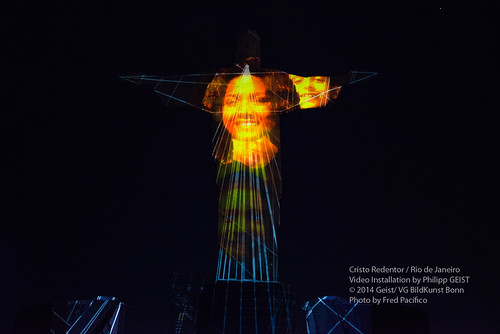 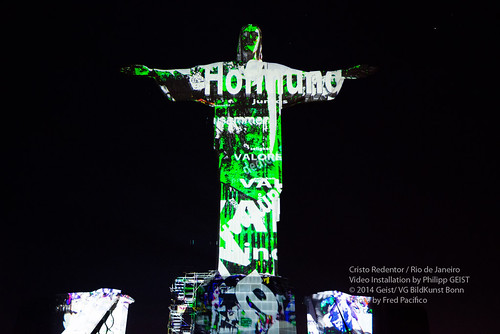 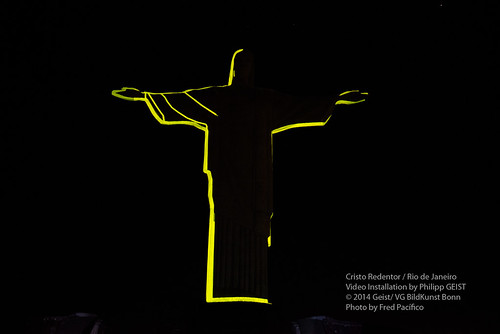 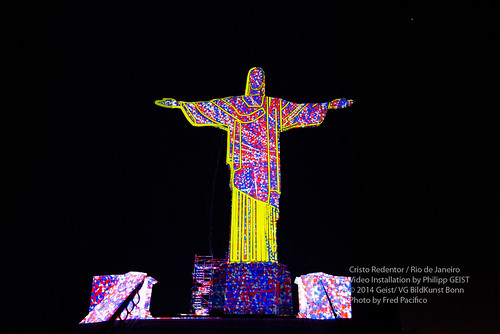 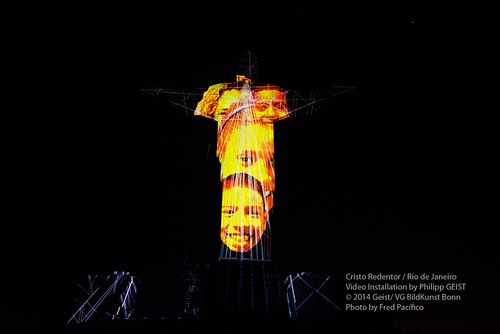 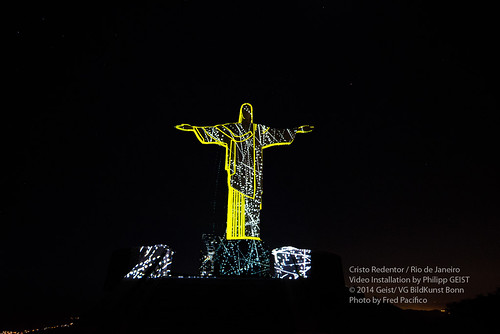 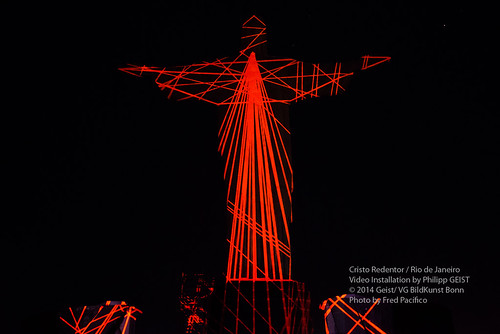 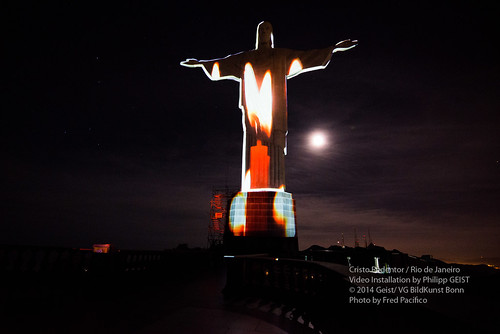 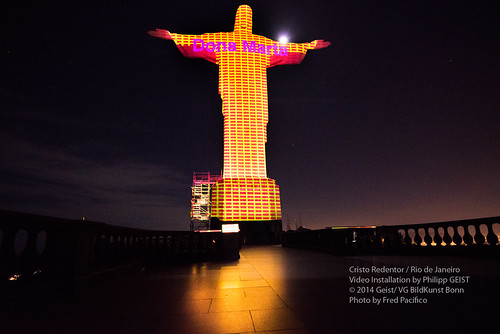 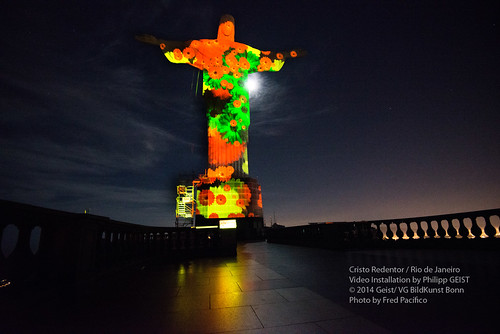 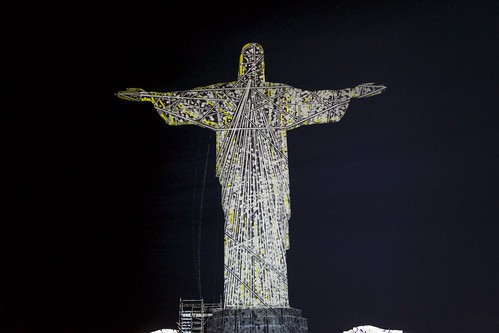  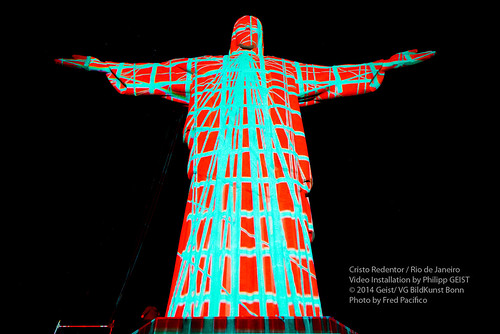 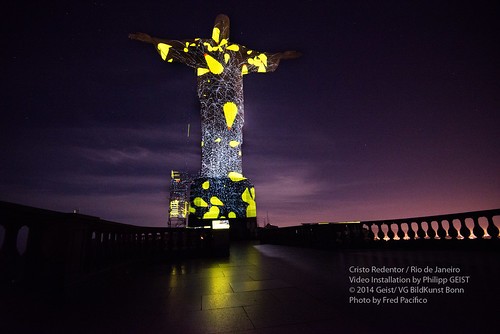 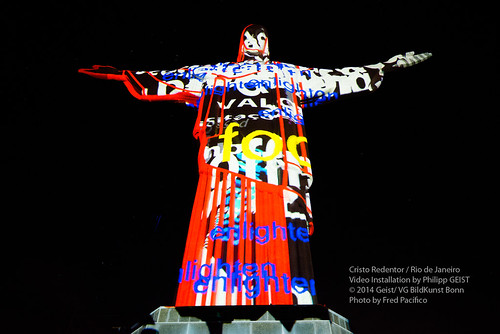 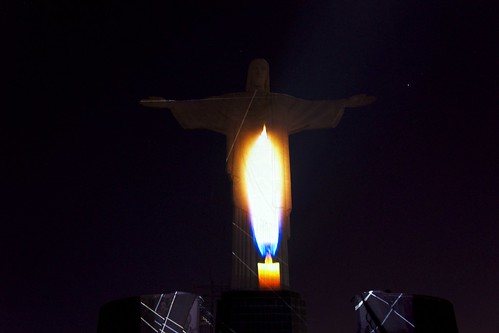  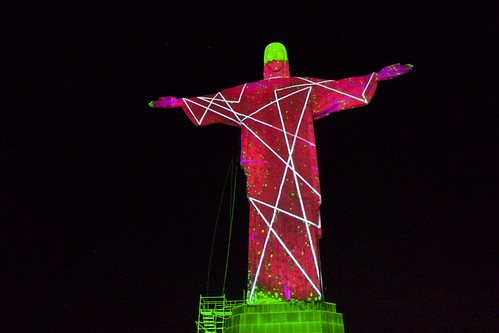  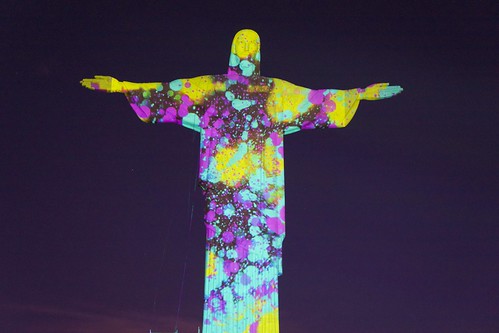  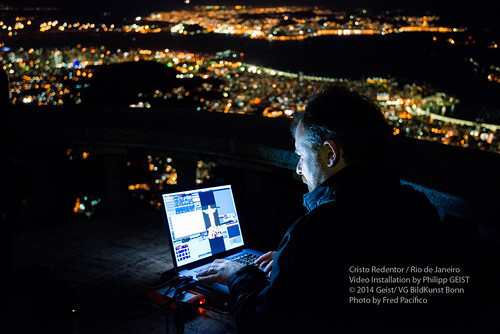 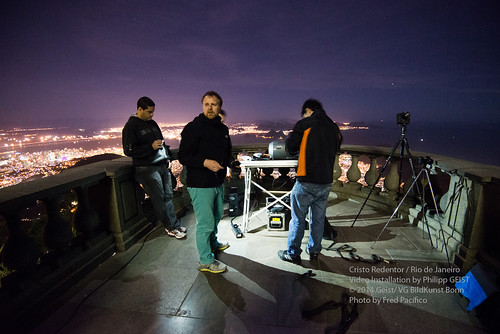 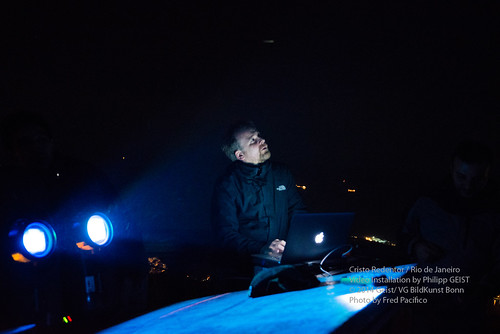 SANTA MARTA 15/16. May 2014 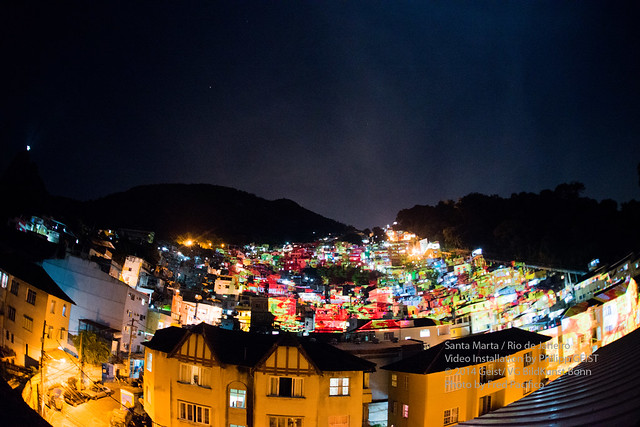 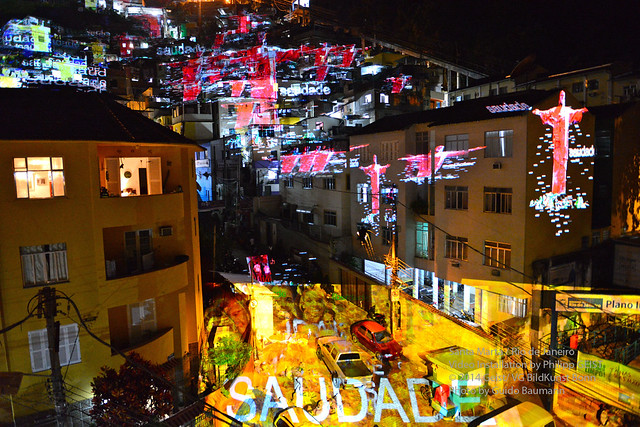  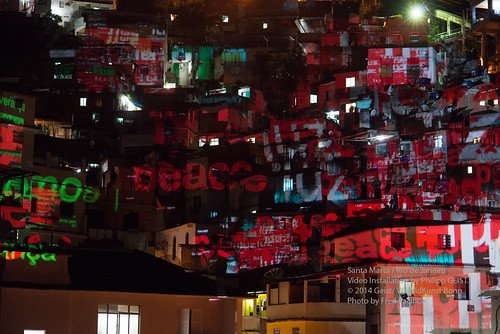  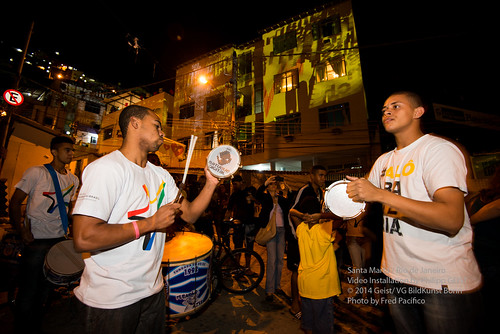 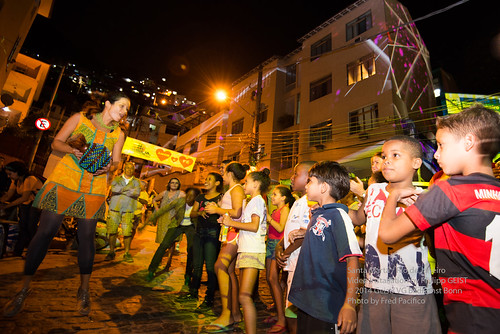 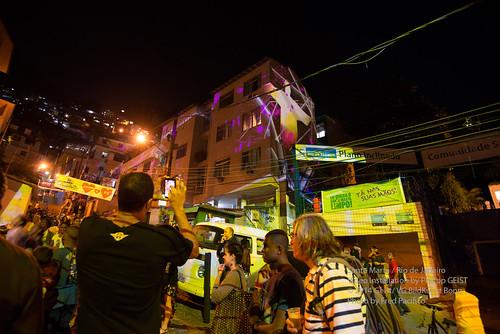 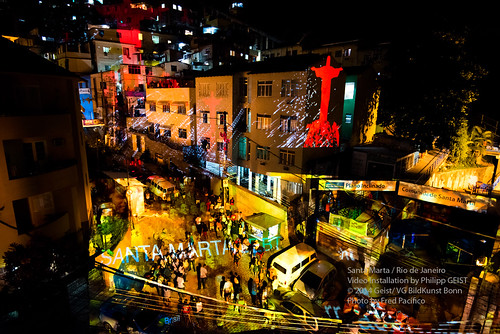 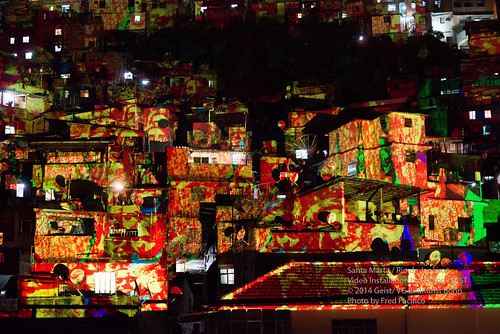 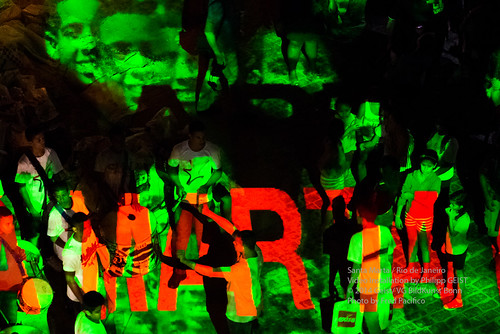 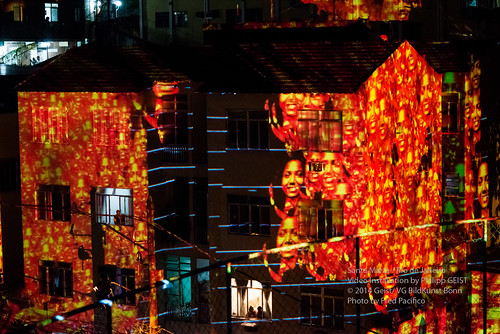 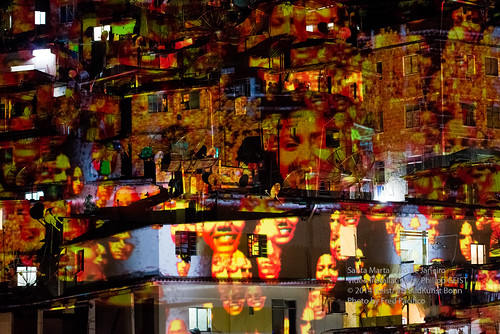 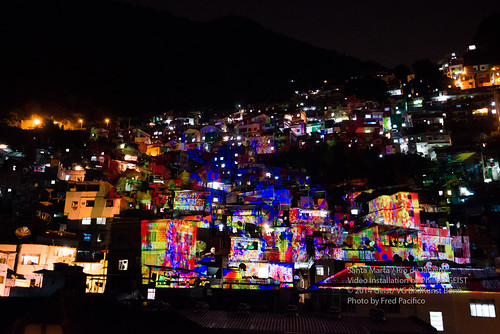 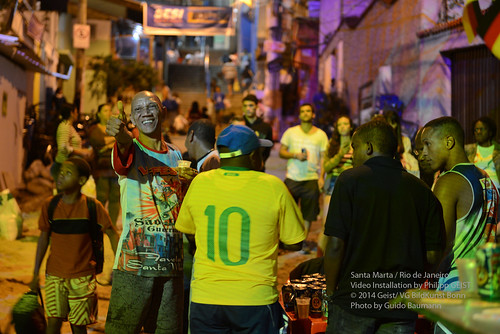  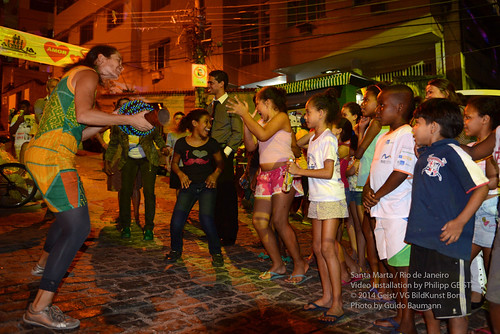 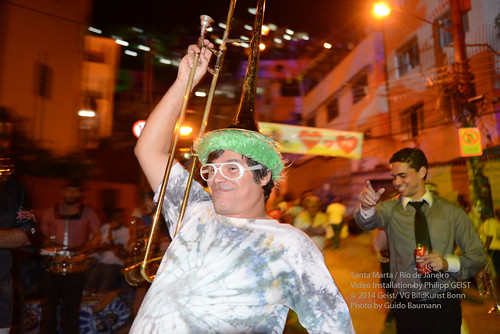 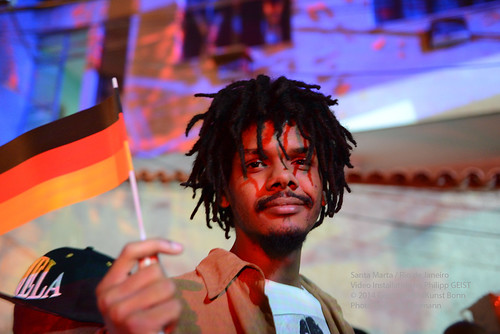 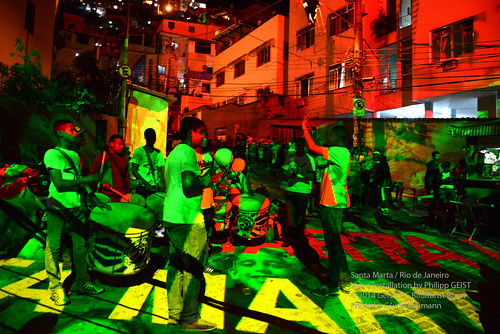  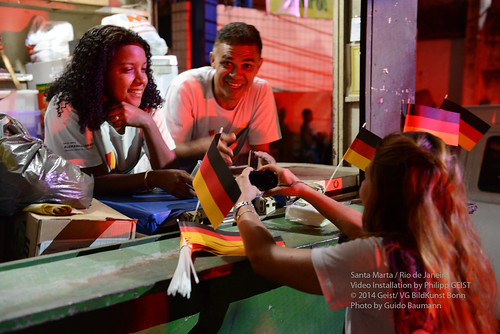  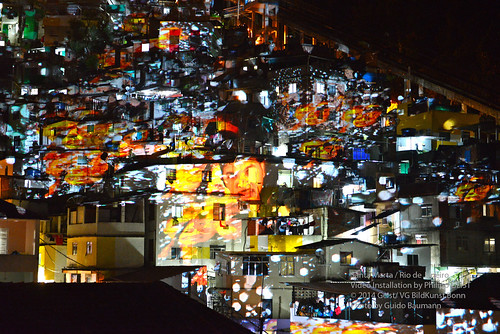 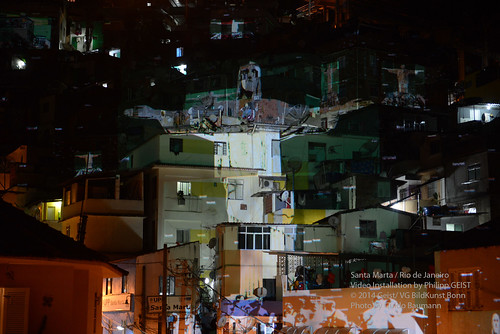  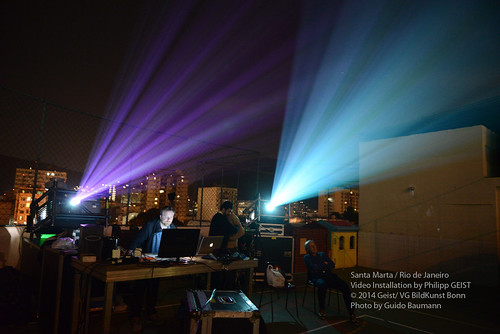 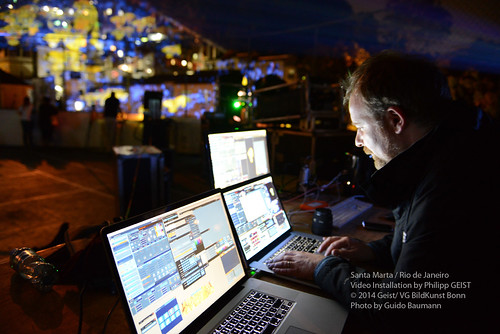 more Installation photos<<https://www.flickr.com/photos/pgeist/sets/72157644653883951/>> <<https://www.flickr.com/photos/pgeist/sets/72157644783293746/>> Presshttp://www.dw.de/projeções-de-luz-colorem-favela-e-cristo-redentor-no-rio/a-17640888 http://lulacerda.ig.com.br/cristo-e-santa-marta-recebem-iluminacao-de-artista-alemao/ http://www.conexaojornalismo.com.br/todas-as-noticias/projecoes-de-luz-colorem-favela-e-cristo-redentor-no-rio-0-27987 Light Art-Video-Mapping-Installations Philipp Geist in Rio de Janeiro / Brazil 2014 on the Christ statue (Cristo Redentor) - May 12 and in the Dona Marta favela - May 15 and 16, 2014 supported by Ministry of Foreign Affairs, consulate-general, project office 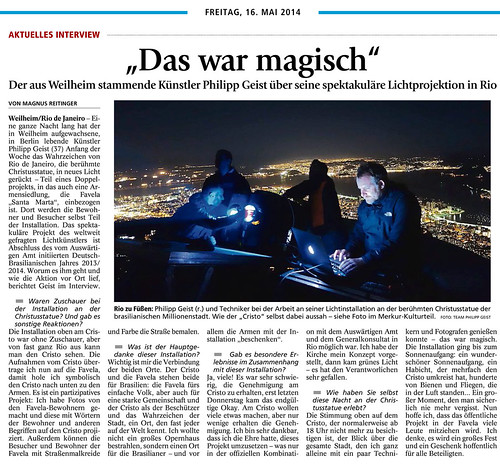  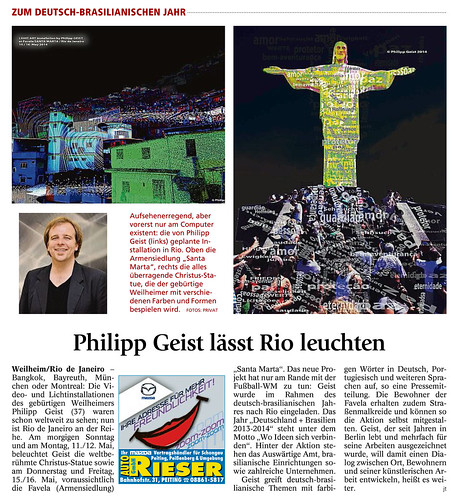 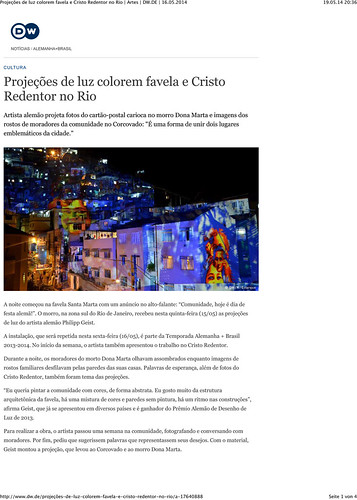 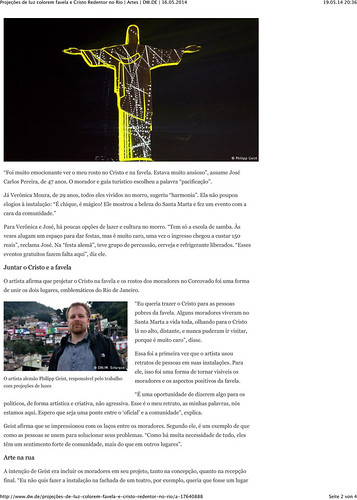  Installation Philipp Geist Year of Germany in Brazil 2013/2014 Concept Time Drifts May 2014 At the end of the Year of Germany in Brazil 2013/2014, the artist Philipp Geist (Berlin, 1976) develops two light installations in Rio this year; the first one on the world-famous Christ statue (Cristo Redentor) and the other installation in the Santa Marta favela. For the installation the artist presents artistic-liberal and poetic German and Brazilian themes and develops a building and floor light installation of colored words and phrases in Portuguese, German, and in other international languages. The installation deals with cultural characteristics and achievements of both countries and visualizes the issues of time and space, volatility and presence in a free artistic style. The two projects are in fact a double project which is combined. The installation on the symbol of Rio and Brazil, the Christ statue, is recorded and projected onto the small buildings and huts of the favela. The Christ statue, which has been built to protect the city and the sailors, is symbolically projected on the shantytown, the favela, in a protective way. The installation in the favela will be seen not only on a facade as a large cinema projection or as a static image, but on several winding buildings, the roofs, the floor and on the steps. Thus, the visitor becomes a part of the installation and can immerse into the projection and the light and introduce himself. Chalk crayons are put out on the streets in the favela and the young and old residents and visitors can write and paint words on the street, the ground, the stairs or even on the house walls. The residents and several institutions should be addressed to submit words and associations dealing with Rio, Brazil and Germany. For the installation, which was shown at the Luminale in 2012, the artist Philipp Geist won the German Lighting Design Award 2013 (Deutscher Lichtdesign-Preis 2013) in the category Light Art. The series 'Time Drifts' is characterized by the complex and subtle way of visualizing various currents and voices in cultural contexts and to provide institutions and visitors with the opportunity of substantive participation: different personalities, visitors and institutions may be addressed in advance and then contribute words and associations. Current and historico-cultural topics are researched in advance by the artist and then integrated in a sensitive and subtle way. The projection dismisses the use of screens, because concepts and associations are projected on a large area onto the floor surface on several facades and in theater fog. Over the course of two days, the installation can be seen on-site in the favela on May 15 and 16 and on the Cristo Redentor on May 12 for a day. Short, tall, young and old visitors can interactively participate in the installation by tracing and adding words with colored chalk crayons available on the streets. Thus, over the period of the installation, a carpet of words is evolved with terms that are contributed locally by the visitors by means of the temporary and volatile 'medium' of chalk crayons. Philipp Geist develops in this way a dialogue between the place, the visitors and his artistic work. The concrete, tangible projection of the architecture and the static terms on the floor area represents the facts and visible relics that are responsible for our understanding of history. The transparent and volatile projection in the fog reminds us that part of the history can not be preserved and that it is created in our individual imagination in a single moment. Words are briefly visible as a metaphor for transience and then disappear again. This interplay of the various text and image layers in the space refers to the location and the history/-ies of Brazil and Germany and the cultural exchange between the two countries. The visitors themselves are part of the installation: they dive into the large floor projection. In this way, different perspectives and experiences of space are unified. Abstract passages which are created, then overlapped and displaced by each other symbolize the constant changes in history, the passage of time and the transience of existence. Even the understanding of the past is in the flux. The modern writings and formations created on the computer establish a connection to the present and the possibilities of today's technology and show that the perception of history and culture depends always on the possibilities and constraints of the present. 'Time Drifts - Words of Berlin' is part of a series of installations, which has been shown in recent years by Philipp Geist, and which are always re-developed site-specifically and adapted to the local conditions: In October 2012, Philipp Geist showed the installation on the entire Potsdamer Platz (public square) and the Kolhoff Tower and Renzo Piano Tower skyscrapers. In April 2012 the installation was shown at the Luminale in Frankfurt where it was seen by more than 40,000 visitors and thus the main project of the Luminale 2012. In 2011, Philipp Geist presented the 'Time Drifts' installation in Vancouver at the Jack Poole Plaza, as well as in Montreal on the Place des Arts in 2010. The 'Timing' installation was shown at the 2009 Glow Festival in Eindhoven. In the end of 2009, on the occasion of the birthday of the King of Thailand, 2-3 million visitors saw his facade installation at the royal throne in Bangkok. Other projects include: 'Timelines' at the prestigious Pallazzio delle Esposizioni (Rome, 2007), 'Time Fades' at the Cultural Forum of Berlin and 'Broken Time Lines' at the old spa Kurhaus Ahrenshoop (Germany, 2008). Geist's projects are primarily characterized by their complexity concerning the integration of space, sound and motion images. His video mapping installations waive screens and transform a wide range of architectures in moving, picturesque light sculptures which challenge the viewer's perception of two- and three-dimensionality. http://www.alemanha-brasil.org/br/node/8542 --------------- Arte de luz - Instalações de Mapeamento de Vídeo por Philipp Geist no Rio de Janeiro / Brasil 2014 no Cristo Redentor no dia 12 de maio e na favela Santa Marta nos dias 15 e 16 de maio de 2014 Instalação Philipp Geist Ano Alemanha + Brasil 2013/2014 Conceito Time Drifts Maio 2014 No final do ano Alemnaha + Brasil 2013/2014, o artista Philipp Geist (1976, Berlim) desenvolverá duas instalações de luz no Rio; uma delas será exibida na mundialmente famosa estátua do Cristo Redentor, e a outra na favela Santa Marta. Para a instalação, o artista traz temas teutobrasileiros de maneira liberal-artística e poética desenvolvendo instalações de luz em edifícios e no solo a partir de palavras e conceitos coloridos em Português, Alemão e em outros idiomas internacionais. A instalação lida com as peculiaridades e realizações culturais de ambos os países e visualiza as questões de tempo e espaço e de volatilidade e presença no estilo liberal-artístico. Os dois projetos em questão representam um projeto duplo que é combinado. A instalação na estátua do Cristo Redentor, como um símbolo do Rio e do Brasil, será gravada e projetada nos pequenos prédios e barracos da favela. A estátua do Cristo Redentor, que foi erguida para proteger a cidade e os marinheiros, será então projetada como um símbolo de proteção em uma favela. A instalação na favela é visto não apenas em uma fachada como uma projeção grande de cinema ou como uma imagem estática, mas em vários prédios sinuosos, em telhados, no solo e nas escadas. Desta maneira, o visitante conseguirá ser parte da instalação e imergir e mergulhar na projeção e na luz. Na favela, será distribuído giz para pintura de rua, e os moradores e visitantes, tanto jovens quanto velhos, podem escrever e pintar conceitos na rua, no solo, nas escadas ou até mesmo nas paredes das casas. Os moradores e diversas instituições serão convidados a contribuir com conceitos e associações que representam o Rio, o Brasil e a Alemanha. Para as instalações apresentadas na Luminal em 2012, o artista Philipp Geist ganhou o 'Deutscher Lichtdesign-Preis 2013" (Prêmio Alemão de Desenho de Luz de 2013) na categoria Arte de Luz. A série Time Drifts caracteriza-se pela forma complexa e sutil de visualizar várias correntes e vozes em contextos culturais e de oferecer a instituições e aos visitantes a oportunidade de participar: diferentes personalidades, visitantes e instituições podem ser contatados antecipadamente para contribuir com termos e associações. Temas atuais, históricos e culturais serão previamente pesquisados pelo artista e, depois, integrados de uma forma sensível e sutil. A projeção é realizada sem o uso de telas porque conceitos e associações são projetados, em grande estilo, sobre a superfície do solo, em diversas frentes e envolvidos em fumaça. Ao longo de dois dias, a instalação estará em exibição em 15 e 16 de maio na favela, e em 12 de maio, por um dia, no Cristo Redentor. Visitantes jovens e velhos podem envolver-se na instalação e traçar ou adicionar palavras com giz colorido, que será distribuído, e assim participar interativamente na instalação. Desta maneira, durante a duração da instalação, será desenvolvido um tapete de palavras. As palavras serão fornecidas, no próprio local, pelos visitantes usando o giz, um meio temporário e volátil. Philipp Geist desenvolve assim um diálogo entre o local, os visitantes e seu trabalho artístico. A área de projeção concreta e tangível da arquitetura e os termos estáticos sobre a superfície do solo representam os fatos e as relíquias visíveis que compõem a nossa compreensão da história. A área de projeção transparente e sumindo por dentro da fumaça lembra que parte da história não pode ser preservada e que ela é criada na nossa imaginação individual momentaneamente. Conceitos são brevemente visíveis, como uma metáfora para a transitoriedade e, logo mais, desaparecem. Esta interação entre as várias camadas de texto e de imagens no espaço refere-se à localização e a(s) história(s) do Brasil e da Alemanha e o intercâmbio cultural entre os dois países. Os próprios visitantes tornam-se parte da instalação: eles imergem na grande projeção do solo. Desta forma, diferentes perspectivas e experiências de espaço são unidas. Passagens abstratas que são formadas, sobrepostas e suprimidas pela próxima simbolizam as mudanças contínuas na história, a passagem do tempo e a transitoriedade da existência. A compreensão do passado também está no fluxo. As fontes e formações modernas criadas no computador estabelecem uma conexão com o presente e com as possibilidades da tecnologia de hoje: a percepção da história e da cultura sempre dependende das capacidades e limitações do presente. 'Time Drifts - Words of Berlin' faz parte de uma série de instalações, que foram apresentadas durante os últimos anos por Philipp Geist e que são sempre redesenvolvidas para as condições locais específicas: em outubro de 2012, Philipp Geist exibiu a instalação em toda a praça Potsdamer Platz (Berlim) e nos dois arranha-céus Kolhoff Tower (Berlim) e Renzo Piano Tower (Londres). Em abril de 2012, a instalação foi apresentada no evento da Luminal em Frankfurt onde foi vista por mais de 40.000 visitantes sendo o principal projeto da Luminal de 2012. Em 2011, Philipp Geist mostrou a instalação Time Drifts na praça Jack Poole Plaza em Vancouver bem como em Montreal, Canadá, no centro de arte Place des Arts, em 2010. A instalação Timing foi exibida no Glow Festival de 2009 in Eindhoven, Holanda. No final de 2009 e por ocasião do aniversário do rei tailandês, aprox. 2 a 3 milhões de visitantes viram a instalação de fachada do artista no trono real em Banguecoque. Seus outros projetos incluem: Time Lines, no prestigiado museu Palazzio delle Esposizioni (Roma, 2007); Time Fades, no Fórum Cultural de Berlim; Broken Time Lines, no antigo spa Kurhaus Ahrenshoop (Alemanha, 2008). Os projetos de Geist são principalmente caracterizados por sua complexidade na integração de espaço, som e imagens de movimento. Suas instalações de mapeamento de vídeo renunciam telas e transformam uma ampla gama de arquiteturas em esculturas móveis e pitorescas que desafiam a percepção do espectador de duas e três dimensões. http://www.alemanha-brasil.org/br/node/8542 --------------- Lichtkunst-VideoMappingInstallationen Philipp Geist in Rio de Janeiro / Brasilien 2014 an der Christstatue (Cristo Redender) 12.5 und in der Favela Santa Marta 15./16.5.2014 Installation Philipp Geist Deutsch-Brasilianisches Jahr 2013/2014 Konzept Time Drifts Mai 2014 Zum Abschluss des Deutsch-Brasilianischen-Jahres 2013/2014 entwickelt der Berliner Künstler Philipp Geist (1976) zwei Lichtinstallation in Rio d.J.; eine an der weltbekannten Christstatue (Cristo Redender) und in die andere Installation in der Favela Santa Marta. Bei der Installation greift der Künstler künstlerisch frei und poetisch deutsch brasilianische Themen auf und entwickelt eine Gebäude- und Boden-Lichtinstallation aus farbigen Wörtern und Begriffen in portugiesischer, deutscher, und in weiteren internationalen Sprachen. Die Installation thematisiert kulturelle Besonderheiten und Errungenschaften beider Länder und visualisiert die Themen Zeit und Raum, Flüchtigkeit und Präsenz in freien künstlerischen Art. Bei den beiden Projekten handelt es sich um ein Doppelprojekt welches kombiniert wird. Die Installation auf das Wahrzeichen von Rio und Brasilien die Christstatue, wird aufgenommen und auf die kleinen Gebäude und Hütten der Favela projiziert. Die Christstatue die errichtet worden ist um die Stadt und Seeleute zu schützen, wird so symbolisch schützend über ein Armenviertel die Favela projiziert. Dabei ist die Installation in der Favela nicht nur auf einer Fassade als große Kinoprojektion oder als statisches Bild zu sehen, sondern auf mehreren verwinkelten Gebäuden, den Dächern, den Boden und auf den Stufen. Der Besucher wird vielmehr auf diese Weise selbst Teil der Installation und kann in die Projektion und das Licht eintauchen und sich einbringen. In der Favela werden Strassenmalkreide ausgelegt und die Bewohner und Besucher ob jung oder alt können Begriffe auf die Strasse, den Boden, die Treppenstufen oder sogar auf die Hauswände schreiben und malen. Die Bewohner und verschiedene Institutionen sollen angesprochen werden Assoziationen und Begriffe die für Rio, Brasilien und Deutschland stehen einzureichen. Für die 2012 bei der Luminale gezeigten Installation hat der Künstler Philipp Geist den Deutschen Lichtdesign-Preis 2013 in der der Kategorie Lichtkunst gewonnen. Die Serie 'Time Drifts' zeichnet sich aus durch die komplexe und die subtile Möglichkeit, verschiedenste Strömungen und Stimmen in kulturellen Kontexten sichtbar zu machen und Institutionen und Besuchern die Möglichkeit zur inhaltlichen Partizipation zu geben: Es können verschiedene Persönlichkeiten, Besucher und Institute im Vorfeld angesprochen werden, die Begriffe und Assoziationen beisteuern. Aktuelle und kulturhistorische Themen werden im Vorfeld vom Künstler recherchiert und auf sensible und subtile Weise integriert. Die Projektion verzichtet auf den Einsatz von Leinwänden, denn Begriffe und Assoziationen werden grossflächig auf die Bodenfläche, auf mehrere Fassaden und in Theaternebel projiziert. Über den Zeitraum von 2 Tagen wird die Installation vor Ort in der Favela am 15/16.Mai und die Installation am Cristo Redentor am 12.Mai für einen Tag zu sehen sein.! Kleine, große, junge und alte Besucher können sich einbringen in die Installation und mit farbiger Straßenmalkreide, die ausgelegt wird, Wörter nachzeichnen und hinzufügen und so interaktiv an der Installation teilnehmen. Über die Installationsdauer entsteht somit ein Wörterteppich aus Begriffen, die vor Ort von den Besuchern selbst mittels dem temporären und flüchtigen 'Medium' der Strassenmalkreide beigesteuert werden. Geist entwickelt auf diese Weise einen Dialog zwischen dem Ort, den Besuchern und seiner künstlerischen Arbeit. ! ! Die konkrete, greifbare Projektionsfläche der Architektur und die statischen Begriffe auf der Bodenfläche stehen für die Fakten und sichtbaren Relikte, welche unser Geschichtsverständnis ausmachen. Die transparente, sich verflüchtigende Projektionsfläche im Nebel erinnert daran, dass ein Teil der Geschichte nicht konserviert werden kann und im Moment in unserer individuellen Vorstellung entsteht. Begriffe werden als Metapher für die Vergänglichkeit kurzzeitig sichtbar und verschwinden sofort wieder. Dieses Zusammenspiel der verschiedenen Text- und Bildschichten im Raum verweist auf den Ort und die Geschichte(n) Brasiliens und Deutschlands und den kulturellen Austausch beider Länder. Die Besucher selbst werden Teil der Installation: sie tauchen in die großflächige Bodenprojektion ein. Auf diese Weise vereinen sich unterschiedliche Perspektiven und Raumerfahrungen. Abstrakte Passagen, die sich aufbauen, überlagern und gegenseitig verdrängen, symbolisieren die ständigen Veränderungen in der Geschichte, den Lauf der Zeit und die Flüchtigkeit des Seins. Auch das Verständnis von der Vergangenheit ist im Fluss. Die modernen Schriften und Formationen, die am Computer entstanden sind, stellen eine Verbindung zur Gegenwart und den Möglichkeiten der heutigen Technik her und zeigen, dass die Erfahrbarkeit von Geschichte und Kultur immer von den Möglichkeiten und Rahmenbedingungen der Gegenwart abhängig ist. 'Time Drifts - Words of Berlin' ist Teil einer Serie von Installationen, die Philipp Geist in den letzten Jahren gezeigt hat, und die dabei immer wieder neu an die örtlichen Gegebenheiten ortsspezifisch weiterentwickelt wird: Im Oktober 2012 zeigte Geist die Installation auf dem gesamten Potsdamer Platz und den beiden Hochhäusern Kolhoff Tower und Renzo Piano Tower. Im April 2012 wurde die Installation in Frankfurt auf der Luminale gezeigt, wurde von mehr als 40.000 Besuchern gesehen und war das Hauptprojekt der Luminale 2012. Im Jahr 2011 zeigte Geist die Installation Time Drifts in Vancouver am Jack-Poole Plaza, ebenso wie in Montreal am Place des Arts in 2010. Die Installation 'Timing' war 2009 auf dem Glow Festival in Eindhoven zu sehen. Ende 2009 sahen anlässlich des Geburtstages des thailändischen Königs ca. 2-3 Millionen Besucher seine Fassadeninstallation am königlichen Thron in Bangkok. Andere Projekte waren u.a.: 'Time Lines' am renommierten Museum delle Esposizioni (2007), 'Time Fades' am Berliner Kulturforum, 'Broken Time Lines' am alten Kurhaus Ahrenshoop (2008). Geists Projekte sind in erster Linie gekennzeichnet durch ihre Komplexität in der Integration von Raum, Ton und Bewegbild. Seine Video-Mapping-Installationen verzichten auf Leinwände und verwandeln verschiedenste Architekturen in bewegte, malerische Lichtskulpturen, die die Wahrnehmung der Betrachter von Zwei- und Dreidimensionalität herausfordern. ! ------------------------------------------------------------------------------------------------ upcoming ------------------------------------------------------------------------------------------------ Scheinwerfer. Lichtkunst in Deutschland im 21. Jahrhundert Teil 2 | 28. Juni – 5. Oktober 2014 Kunstmuseum Celle mit Sammlung Robert Simon GUDRUN BARENBROCK | SHAN BLUME | BJÖRN DAHLEM | GÜNTER DOHR | SVEN DRÜHL | GUNDA FÖRSTER | MAX FREY | PHILIPP GEIST | ATELIER GOULBIER | HELGA GRIFFITHS | LISA HASELBEK | HARTUNG TRENZ | DANIEL HAUSIG | SEBASTIAN HEMPEL | HERMELINDE HERGENHAHN | ALBERT HIEN | CHRISTOPH HILDEBRAND | AIL HWANG | CONSTANTIN JAXY | DIETER JUNG | KAZUO KATASE | HANS KOTTER | MISCHA KUBALL | VOLLRAD KUTSCHER | MADER WIERMANN | CHRIS NÄGELE | BORIS PETROVSKY | MARTIN PFEIFLE | OTTO PIENE | TOBIAS REHBERGER | MICHAEL SAILSTORFER | SIGRID SANDMANN | ALBRECHT SCHÄFER | DETLEF SCHWEIGER | HELMUT SCHWEIZER | PAUL SCHWER Eröffnung 28. Juni, 20 Uhr Die Überblicksschau ?Scheinwerfer“ zeigt erstmals Deutschland als Lichtkunst-Landschaft mit internationaler Reichweite. Jetzt geht das Projekt in die zweite Runde: 36 Künstlerinnen und Künstler beziehend leuchtend Position im Kunstmuseum und im Stadtraum von Celle. Der Katalog mit einer umfassenden Dokumentation des Gesamtprojekts erscheint im Okto-ber 2014. Vorbestellung unter kunstmuseum@celle.de Die Ausstellung ?Scheinwerfer. Lichtkunst in Deutschland im 21. Jahrhundert“ wird auf Beschluss des Bundestages durch den Beauftragten der Bundesregierung für Kultur und Medien gefördert. Darüber hinaus wird das Projekt vom Land Niedersachsen, der Stadt Celle und weiteren Förderern begleitet. Kunstmuseum Celle mit Sammlung Robert Simon – Das erste 24-Stunden-Kunstmuseum der Welt Schlossplatz 7 | 29221 Celle | Tel. (0 51 41) 12 685 | kunstmuseum@celle.de | www.kunst.celle.de Kunstmuseum Celle mit Sammlung Robert Simon <<http://www.celle.de/index.php?&ffsn=false&object=tx|2092.1429.1&ModID=7&FID=326.9625.1&kat=&kuo=2&k_sub=0&La=1>> ------------------------------------------------------------------------------------------------ TV REPORT 12/2013 ------------------------------------------------------------------------------------------------ Deutsche Welle TV - Euromaxx - ENGLISH DwTV Euromaxx Geist 301213 http://www.youtube.com/watch?v=abcViE8uSTk DwTV Euromaxx Geist 301213 - ESPAÑOL http://www.youtube.com/watch?v=AQpV9VEFx84 DwTV Euromaxx Geist 301213 - Deutsch http://www.youtube.com/watch?v=7MDQN0vF-Gc Tv Beitrag Tagesschau Tagesschau Philipp Geist Lichtkünstler Dez 2013 http://www.youtube.com/watch?v=-7KtzDiYC5U ------contact--------------------------------------------------- Philipp Geist Studio Post Box 080311 10003 Berlin/ Germany mail@p-geist.de <<http://www.philipp-geist.de/>> <<http://www.videogeist.de/>> <<http://videogeist.blogspot.de/>> <<http://www.facebook.com/videogeist>> ________________________________________________________________ for (un)subscribe please email '(un)subscribe' to mail@p-geist.de ________________________________________________________________ in seh |
Dienstag, 27. Mai 2014
news #3-2014 Philipp Geist Studio // Review/ Rückblick Rio de Janeiro Cristo Redentor & Santa Marta / upcoming Kunstmuseum Celle Scheinwerfer II 28.Juni - 05.Oktober 2014
Abonnieren
Kommentare (Atom)